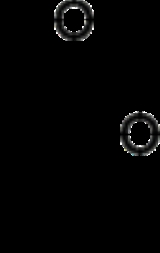
2-Pyrone
Encyclopedia
2-Pyrone is an unsaturated
cyclic chemical compound with the molecular
formula C5H4O2. It is isomer
ic with 4-pyrone
.
2-Pyrone is used in organic synthesis
as a building block for more complex chemical structures because it may participate in a variety of cycloaddition reactions to form bicyclic lactone
s. For example, it readily undergoes Diels-Alder reaction
s with alkyne
s producing, upon loss of carbon dioxide
, substituted benzene
s. The Gogte Synthesis (1938) is a method for the alkylation of certain pyrones with acid chlorides.
The most common natural products containing a 2-pyrone are the bufanolides and kavalactone
s.
Saturation (chemistry)
In chemistry, saturation has six different meanings, all based on reaching a maximum capacity...
cyclic chemical compound with the molecular
Molecule
A molecule is an electrically neutral group of at least two atoms held together by covalent chemical bonds. Molecules are distinguished from ions by their electrical charge...
formula C5H4O2. It is isomer
Isomer
In chemistry, isomers are compounds with the same molecular formula but different structural formulas. Isomers do not necessarily share similar properties, unless they also have the same functional groups. There are many different classes of isomers, like stereoisomers, enantiomers, geometrical...
ic with 4-pyrone
4-Pyrone
4-Pyrone is an unsaturated cyclic chemical compound with the molecular formula C5H4O2. It is isomeric with 2-pyrone....
.
2-Pyrone is used in organic synthesis
Organic synthesis
Organic synthesis is a special branch of chemical synthesis and is concerned with the construction of organic compounds via organic reactions. Organic molecules can often contain a higher level of complexity compared to purely inorganic compounds, so the synthesis of organic compounds has...
as a building block for more complex chemical structures because it may participate in a variety of cycloaddition reactions to form bicyclic lactone
Lactone
In chemistry, a lactone is a cyclic ester which can be seen as the condensation product of an alcohol group -OH and a carboxylic acid group -COOH in the same molecule...
s. For example, it readily undergoes Diels-Alder reaction
Diels-Alder reaction
The Diels–Alder reaction is an organic chemical reaction between a conjugated diene and a substituted alkene, commonly termed the dienophile, to form a substituted cyclohexene system. The reaction can proceed even if some of the atoms in the newly formed ring are not carbon...
s with alkyne
Alkyne
Alkynes are hydrocarbons that have a triple bond between two carbon atoms, with the formula CnH2n-2. Alkynes are traditionally known as acetylenes, although the name acetylene also refers specifically to C2H2, known formally as ethyne using IUPAC nomenclature...
s producing, upon loss of carbon dioxide
Carbon dioxide
Carbon dioxide is a naturally occurring chemical compound composed of two oxygen atoms covalently bonded to a single carbon atom...
, substituted benzene
Benzene
Benzene is an organic chemical compound. It is composed of 6 carbon atoms in a ring, with 1 hydrogen atom attached to each carbon atom, with the molecular formula C6H6....
s. The Gogte Synthesis (1938) is a method for the alkylation of certain pyrones with acid chlorides.
The most common natural products containing a 2-pyrone are the bufanolides and kavalactone
Kavalactone
Kavalactones are a class of lactone compounds found in the kava shrub.-Compounds:At least 18 different kavalactones have been identified to date, with methysticin being the first identified.Analogues, such as ethysticin, have also been isolated....
s.

